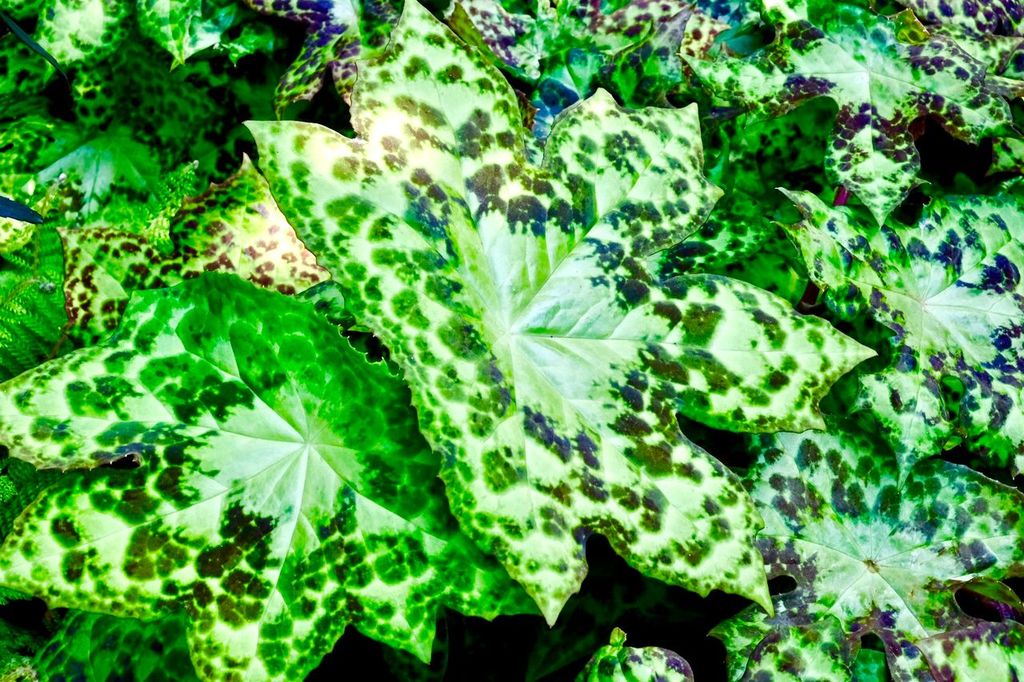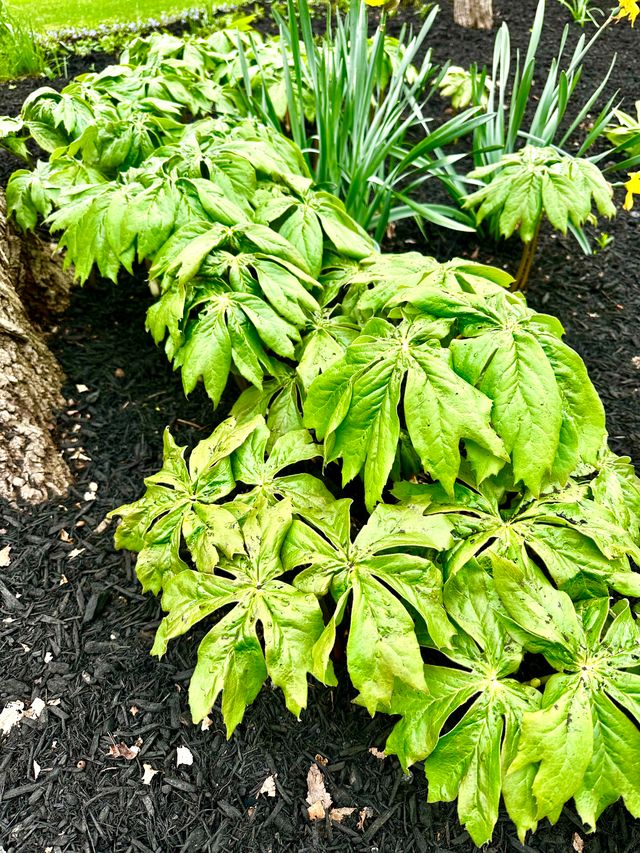
On my travels throughout the years, I’ve noticed an unusual shade plant with large spotted leaves. My first encounter was in Ireland when I visited Lakemount Gardens just north of Cork. It turned up again in the fifteen-acre garden of Janet Blair in New Zealand. One of my savvy travel cohorts reeled off the name ‘Spotty Dotty’, then added “it is a podophyllum. The common name is mayapple!”
On subsequent excursions, I discovered that ‘Spotty Dotty’ thrived in the moist woodlands of Japan, Scotland, and France. OpdeHaar Gardens in the Netherlands, well-known for its woodland and shade-tolerant plants, grows several varieties of podophyllums. On a recent trip to England, I saw a beautiful specimen at Trebah Garden in Cornwall. It popped up again in the Exotic Garden at the Royal Horticultural Society Garden Wisley in Surrey.
PODOPHYLLUM IN CANADA
Just over the border is the Royal Botanical Garden in Burlington, Canada’s largest botanical garden, encompassing over 2,100 acres. For a stunning foliage combination, ‘Spotty Dotty’ is paired up with heuchera ‘Quilter’s Joy’. The sharply lobed leaves of the coral bells look quilted with crisp silver markings on a shiny bronze backdrop, highlighting the mottling on the mayapple.
MAYAPPLES IN THE UNITED STATES
Closer to home, I spotted ‘Spotty Dotty’ growing in the Asian woodland garden at Chanticleer in Wayne, Pennsylvania in both pots and in the ground!
Further south, the Norfolk Botanical Gardens, Virginia’s largest, spanning 175 acres, grows several podophyllum including the mayapple that is native to parts of Western New York, two species of the Chinese mayapple, the spotted mayapple, and the Himalayan mayapple.
On the east coast, Wave Hill in the Bronx has the perfect growing conditions for mayapples. “YES, we grow podophyllum ‘Spotty Dotty’! And we love her. She puts on quite the show,” says Jess Bray, senior horticultural interpreter. “The Berberidaceae are an underappreciated family of plants and ‘Spotty Dotty’ is an outstanding cultivar. We also grow P. peltatum, the native mayapple, in our woods and shade border.”

NATIVE VS. COSMOPOLITAN.
So why not pair up the native mayapple with the cosmopolitan ‘Spotty Dotty’ in your garden? The term “cosmopolitan” is used to describe a plant species with widespread distributions, thus grown in many regions or continents around the globe. The Antarctic and Arctic are the exceptions, where temperatures are too extreme. The plants can be native or non-native. Most species are known to be highly conformable with a gamut of environmental and climatic conditions.
Carl Linnaeus first described the genus Podophyllum in 1753 and, according to Plants of the World Online, there are about seventeen species worldwide. P. peltatum is a native that grows from southeast Canada to the central and eastern United States including most of Western New York. It is hardy in zones 6 to 9 and grows in dense colonies in moist soils in part to full shade. White, yellow, or red blooms appear in April and May and attract pollinators such as bumblebees and other long-tongued bees. The blooms mature into a green, yellow or red fleshy fruit later in the summer, thus the common name mayapple. They are a larval host for the golden borer moth and the mayapple borer. Plants spread slowly by rhizomes and can be propagated by root division in the fall while the plant is dormant. Seed-grown plants take several years to mature. Although the native mayapple goes dormant by mid-summer, it makes a stunning statement in the spring garden.
‘Spotty Dotty’, a vigorous hybrid of P. delavayi x difforme, is as easy to grow as the familiar American mayapple. It is a rhizomatous perennial with large, mottled, parasol-like foliage. Plants grow 12 to 18 inches tall in part to full shade in organically rich, moist, well-drained soil. In spring, clusters of nodding maroon flowers dangle under the palmately-lobed leaves, then morph into round, fleshy fruit by late summer. Plants are propagated asexually by tissue culture. Fortunately, deer and rabbits dislike ‘Spotty Dotty’.
ADD TO YOUR SHADE GARDEN
Locally, you can visit Sarah’s Garden and Nursery in Brockport to purchase P. peltatum. Call first to be sure they have plants available. Online sources include Plants Delight Nursery in Raleigh, North Carolina. It lists nine podophyllum species including ‘Spotty Dotty’ and two cultivars of P. peltatum, ‘Maid Marion’ and ‘Wagon Wheels’. At Far Reaches Farm in Port Townsend, Washington, several species are listed on the website as well.
So what will you add to your garden this year —a trusty native or a dramatic cosmopolitan? How about both?
Colleen O’Neill Nice is a horticulturalist who is passionate about plant propagation and enjoys nurturing her garden in Clarence, New York.
This article originally appeared in the July/August 2025 issue of Upstate Gardeners’ Journal.
Views: 15




